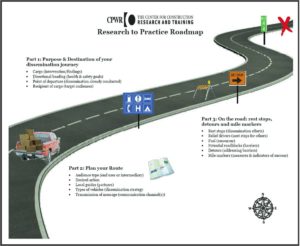Research to Practice (r2p) (Completed – 2009-2014)
Robin Baker, MPH
CPWR
Ph: (510) 643-8900
[email protected]
In its third year, CPWR’s Research to Practice (r2p) initiative is making significant progress in raising awareness and advancing the adoption of evidence-based safety and health practices in construction through the study and promotion of partnerships.
The Masonry r2p Partnership, which was developed as a model national industry partnership, regularly convenes contractors, union representatives, manufacturers, government officials, and academics to develop initiatives to protect those working in the masonry industry. Important new efforts initiated this year focused on protecting one of the workers’ most valuable assets – their hands. Through this initiative, the partnership took available research on preventing skin disorders and hand and wrist injuries and translated it into practical information that workers and contractors can use to select hand tools that are “ergonomically” designed for individual workers, and to raise awareness of the types of gloves and additional protective
measures to avoid dermatitis and other skin disorders caused by chemicals in products commonly used.
The Partnership was also among the valued contributors to the Work Safely with Silica website, and labor and management members of the partnership were among the first to sign on as official supporters of the site. This website, www.silica-safe.org, is a one-stop source of information to help contractors, workers,
and other stakeholders prevent silica-related illnesses. The site includes an innovative tool, “Create-A-Plan,” which allows contractors to develop job-specific plans to control silica dust and prevent exposures. The Work Safely with Silica website is fast becoming a recognized source of reliable information, with
OSHA listing it on its Silica Rulemaking website as one of only six recommended “Scientific and Technical Resources.”
Multiple partners have joined the effort to thwart the No. 1 killer of construction workers: falls from heights. The r2p team’s evaluation of the national fall prevention campaign, Safety Pays, Falls Cost, documented exciting local initiatives that take social marketing messages to a deeper level. Two Latino Fall Prevention partnerships identified promising approaches to reach Latino workers and the small contractors who employ them. In Philadelphia, PhilaPOSH has worked with OSHA to identify contractors in need of help with their fall prevention practices and provided bilingual training. In California, the Labor Occupational Health Program at U.C. Berkeley has been working with an advertising agency to develop marketing messages for employers of Latino construction workers and with workers’ comp insurers to help get out the message.
CPWR, OSHA, and NIOSH continued their collaboration through the r2p Working Group to support multiple research-topractice efforts, including:
- Wide promotion of information on the dangers of nail guns,
- A patent and licensing guide, developed based on a recommendation from the CPWR Technology Transfer Symposium, to facilitate technology transfer from the research to the worksite,
- A continuing exploration of avenues to communicate with small residential construction contractors, a hard-to-reach industry sector which incurs a disproportionate number of workplace injuries and deaths,
- An interagency workshop on the critical concepts of “safety culture” and “safety climate” – how we influence them and how we measure them, and
- Outreach to Career and Technical Education programs (formerly known as “vocational education”) to engage these training programs in safety outreach.
In June 2013, CPWR convened a first ever meeting of construction safety and health partnerships. Representatives of seven partnerships, including ones identified through the case studies and those established through CPWR’s r2p initiative, met to share and advance partnership best practices and provide
guidance on a new “Partnership Toolkit” – a collection of case examples, tools, and resources.
Drawing from the lessons learned from these partnership successes and models, CPWR is generating interest among other industry groups to form partnerships to promote occupational safety and health in the construction industry.
Mapping the Way
The r2p team completed and refined a “Research Dissemination Roadmap” to guide CPWR’s Research Consortium members as they plan how to promote the use of their findings “in the trenches and on the steel.” Researchers are urged to consider – among other things – their “cargo” (the intervention or findings to be delivered), their “point of departure” (dissemination steps already taken), “local guides” (knowledgeable local partners who can help in the r2p effort), and the best “vehicles” for the journey (dissemination strategies that will be most effective).
- Held two national workshops, one related to Safety Culture and the other to r2p Partnerships.
- Published several reports and other documents, including: A full Asphalt Partnership report, a success story summarizing the Asphalt Partnership case study, an Intellectual Property Patent & Licensing Guide for Construction Safety & Health Researchers, and additional reports: Safety Culture/Climate Assessment and Improvement in Construction: Existing Evidence and a Path Forward; a Literature Review and Environmental Scan for Better Translation of Research to Practice in Residential Construction; and Integrating Occupational Safety and Health Training into Career Technical Education in Construction: Formative Research Findings.
- Updated both www.stopconstructionfalls.com and www.silica-safe.org, and promoted the sites through various trade journals and other outlets.
- The team created CONDOR, an outreach database containing nearly 3,500 industry leaders interested in construction health and safety issues.
